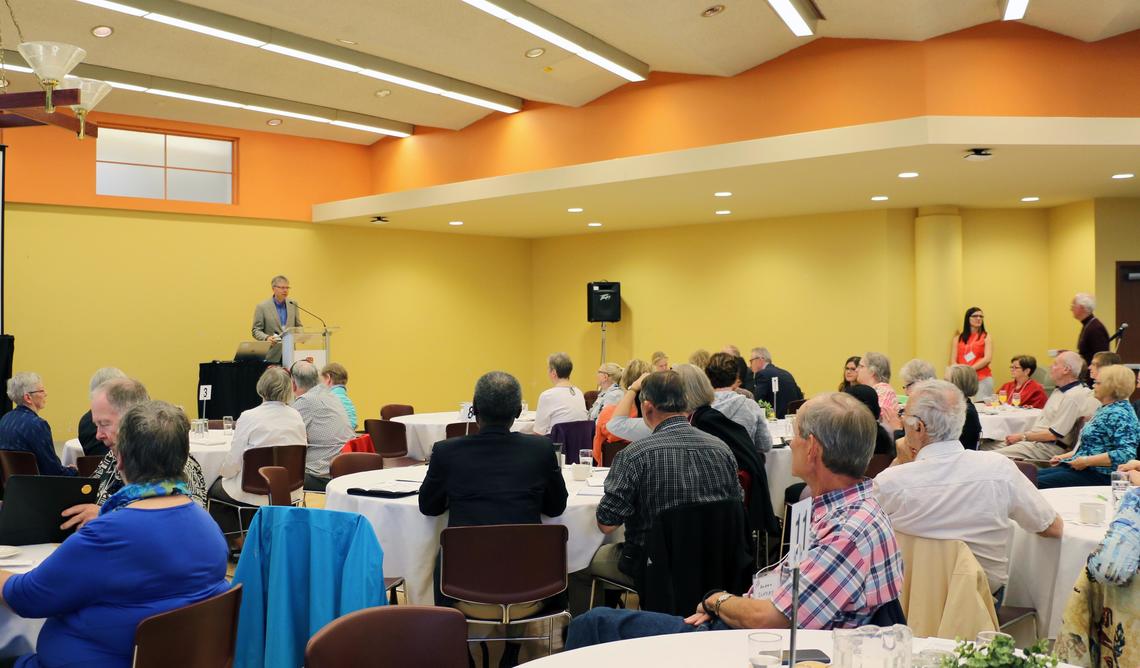May 6, 2016
Exercise can prevent aging brain diseases, research shows

That extra walk you fit in after dinner, or gym session before work, aren’t just good for maintaining a healthy weight — they also play a role in protecting your brain as it ages.
Translating this knowledge into effective public policy to promote higher levels of physical activity among Albertans was the focus of a two-day community engagement forum that brought researchers, practitioners, policy-makers, and community members together at the University of Calgary in April.
Active Living for Healthy Brains was presented by the Brain-in-Motion Study (BiM) and funded by Alberta Innovates Health Solutions (AIHS) in partnership with the Hotchkiss Brain Institute (HBI), and the O’Brien Institute for Public Health. The event brought, to the policy sphere, the most current research on the role physical activity plays in preventing age-associated cognitive decline and in enhancing mental health.
Exercise has more lasting effect than pharmaceuticals
“Exercise is the only intervention that has been shown to have a disease-modifying effect for diseases of the aging brain like dementia or Alzheimer’s,” said Marc Poulin, PhD, a member of the HBI, the Libin Cardiovascular Institute, and professor in the Cumming School of Medicine and Faculty of Kinesiology.
Stewart Longman, adjunct assistant professor, Department of Psychology, told the forum that exercise has also proven to make people happier — unlike medication, which only makes people less sad — and to have a more lasting effect than pharmaceuticals, as shown in research.
With the number of older Canadians doubling over the next 25 years, the burden of age-associated illnesses like dementia will increase substantially and pose a significant challenge to the health-care system, added Poulin.

Marc Poulin speaks at Active Living for Healthy Brains.
Gaining a better sense of exercise's effects
The BiM study enrolled 250 inactive older adults in an 18-month aerobic exercise program, and measured things like cardio-respiratory fitness, genetic risk factors, sleep, and cognitive function.
“We know there are various cognitive components that are impacted by exercise,” said Poulin, the study’s principal investigator. “We wanted to get a better sense of the underlying mechanisms behind this and the practical applications of this knowledge.”
Poulin said his team is also working to better understand the barriers, real and perceived, that older adults face when trying to increase their physical activity level. He notes the BiM team is working with the Alberta Government, the City of Calgary, and other community partners to look at the role public policy plays in helping people become more active.
'Human beings were built to engage in physical activity'
Roger Kramers, executive director of Alberta’s Recreation and Physical Activity Division, said the province is committed to designing programs, delivering services and making investments related to recreation, active living and sport.
“Human beings were built to engage in physical activity on a regular basis,” says Kramers, who gave the keynote address at the forum.
Strategic community design — including outdoor recreation spaces and planning for active transportation such as walking and cycling — can reduce the number of sedentary hours people spend inside and improve activity levels, added Kramers.
City of Calgary representatives Stephanie Wong and Joyce Tang acknowledged the need for a more health-focused approach to city planning. According to Wong and Tang, things like inadequate transportation or lack of fitness facilities can be a barrier for older Calgarians trying to increase their activity levels.
Wong says the city is on the right track and has implemented a senior’s age-friendly strategy, which prioritizes community support, housing, transportation, and access to services to help older Calgarians remain active and engaged in their communities.
Two studies coming for follow-up and older adults with risk factors
Poulin said plans are already underway for two additional studies. First, there will be a five-year follow-up for participants who completed BiM. Next, BiM II will follow older adults with risk factors such as obesity, high blood pressure, pre-diabetes or diabetes, mild-cognitive impairment, or a family history pre-disposing them to dementia or Alzheimer’s.
In addition to AIHS, the O’Brien Institute for Public Health and the HBI, Active Living for Healthy Brains was made possible through support from The Brenda Strafford Centre on Aging, The Brenda Strafford Foundation Chair in Alzheimer Research, the Canadian Institutes for Health Research (CIHR), the CAIP Chair in Healthy Brain Aging, the Heart and Stroke Foundation Chair in Stroke Research, the Heart and Stroke Foundation of Alberta / Hotchkiss Brain Institute Chair in Stroke Research, and Campus Alberta Neuroscience.
For more information on these studies, or to find out how to participate, contact the BiM study co-ordinator at bimstudy@ucalgary.ca or 403-220-7315.
Led by the HBI, Brain and Mental Health is one of six strategic research themes guiding the University of Calgary toward its Eyes High goals.
